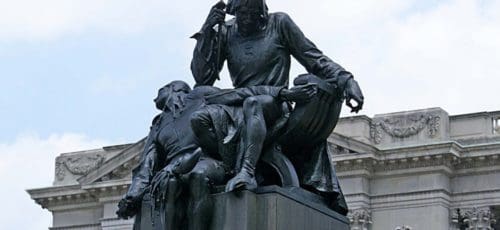A Few Questions With Rafael Lozano-Hemmer, Creator Of Open Air
One of the biggest surprises of the upcoming Live Arts Festival this September will be one seen by everybody in Philly—not just ticket holders. Every night, from September 20th until October 14th, Open Air, a major visual art installation, will light up the skies, created by a series of high-powered searchlights installed on a half mile stretch of Benjamin Franklin Parkway. Download the right app and call in, and the lights will not only dance to the sound of your voice, but they’ll change their layout so that you, from where you’re standing, will have the best view.
This world premiere project, commissioned by the Association for Public Art (formerly Fairmount Park Art Association), and co-presented by the Philadelphia Live Arts Festival (us!), is designed by Rafael Lozano-Hemmer. The Mexican-Canadian bills himself as an electronic artist who develops large-scale interactive installations that are at the intersection of visual art, architecture, and performance art. His work has been featured at all the important places! (Including the 2010 Vancouver Olympic Games.) We caught up with him to gain more perspective on this unique installation, and the process of the artist.
Live Arts: Why is the show named Open Air?
Rafael Lozano-Hemmer: It is a piece about making the air an open platform for participation, like a free, open space for expression using electronic technologies and powerful lights that take over the sky over Philly, a city with a tradition of free speech.
LA: Why did you choose the various technologies you did for Open Air?
RL: There are three main technologies, all with a military background: searchlights, Internet and GPS.
Searchlights were used in the 19th century to signal the arrival of modernity, to make visible a new energy called electricity. Then they were used at war for anti aircraft surveillance and after the second world war for Victory parades. Now we associate them with corporate shows or the opening of a new mall. I seek to use them to amplify the voice of participants to an urban scale, to use them architecturally to create a visible communication matrix.
The internet likewise has a military history, as it was developed by the Pentagon for distributed communication and control. For Open Air, the network is the means through which people can participate at a distance, and with the advent of the smartphone, they can do so from their own personal device.
GPS was developed by the Department of Defense to provide location information around the planet. Today all smartphones are equipped with GPS tracking which give the system awareness of the global position. With this we can vary our light designs so that the actual “proscenium” of the work changes to face the location of a particular participant in the city.
LA: Why, when the lights are responding to your voice, do they search you out?
RL: When you participate, the system knows your position and rearranges all the light vectors to give you a personal vantage point. The design will look best from your perspective. When no one is participating a canopy of light is created which is more decentralized and can be seen from most vantage points.
LA: What’s the most important thing about creating work on a grand scale?
RL: The most important thing of working on a grand scale is to create intimacy and not intimidation. While the show will be spectacular in scale what matters to me is that individual participants can personalize their city with their contributions.
LA: Please discuss the relationship between the intimate (speaking into your phone) and the spectacle (the searchlights) .
RL: The piece consists of an overlay of the real and the virtual. Your location in space changes the location of the light array and your voice changes the behavior of the array. All of this happens through technologies that can be (and often are) used for ominous purposes, but here the idea is to underline connective, poetic ways of using them. Spectacles are typically pre-programmed, passive and follow a cathartic score. In Open Air this is not the case, the piece has no beginning and no end . . . in that sense it is closer to a water fountain than a typical fireworks or son-et-lumière show.
LA: How do you hope the work evolves over the course of its run?
RL: Hopefully through the media and through word of mouth people will find out that those lights are controlled by participation. As more and more people create light designs with their voice, and tune-in to the resulting sound program, we will see more variety, until the piece is a reasonable representation of the city’s past and present.
Thanks Rafael, we look forward to it!




